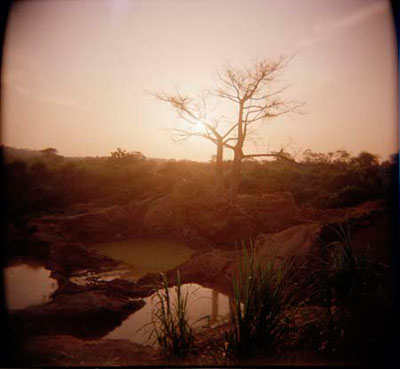Green grow the diamonds
Part 1 of 2

Diamond mines outside the jungle that surrounds
the northern town of Koidu in Sierra Leone
photo courtesy Dave Tacon Photography
Under the best of circumstances, it might require on average 250 tons of diamond bearing rock called Kimberlite to produce a gem quality 1 carat diamond, although some sites vary considerably. Still, the volume of rock and earth that must be transported and sifted for its diamond lode is enormous and can leave a significant mark on the landscape (view satellite photos of mine sites at Greener Earth Maps).
Born in the depths of the earth (diamonds typically form at a depth greater than 150 kilometers, 93 miles within the earth) under tremendous heat and pressure diamonds, often considered one of earth’s rarest treasures, may by some estimates prove in fact to be one of the most common mineral crystals known to man. This past year mining giant Rio Tinto announced a record number of new Kimberlite discoveries and as technology improves there are sure to be many more.
 According to the Smithsonian’s American Museum of Natural History exhibit, “Diamonds,” until the early 1700s India was the world’s sole source of diamonds with an estimated maximum of 50,000 – 100,000 carats mined annually. By the mid 19th century diamonds had been discovered in S Africa and since deposits have been identified in 25 other nations and virtually on every continent. The total number of carats mined around the world today exceed 100 Million carats annually, the totals continue to rise as new technologies and more powerful tools are brought to the task, but at what price?
According to the Smithsonian’s American Museum of Natural History exhibit, “Diamonds,” until the early 1700s India was the world’s sole source of diamonds with an estimated maximum of 50,000 – 100,000 carats mined annually. By the mid 19th century diamonds had been discovered in S Africa and since deposits have been identified in 25 other nations and virtually on every continent. The total number of carats mined around the world today exceed 100 Million carats annually, the totals continue to rise as new technologies and more powerful tools are brought to the task, but at what price?
Increasingly diamond mining requires more resources and results in a substantially greater impact on the environment as mining concerns look father a field and deeper beneath the ground for new deposits. While S Africa remains for the near future the lead supplier of diamonds contributing overall a total of 45% of all production, so too do they bear the greatest wounds. Abandoned mines and impoverished communities continue to burden the economies of third world nations like South Africa long after the diamonds and the wealth they represent have been removed. Scarification and waste lay in the debris of these activities even as corporations strive to minimize the impact such mining has on local eco systems.
However, even that damage is minimal compared to the damage in human terms when mines are closed and jobs eliminated. Now left with no viable industry and a wrecked landscape the inevitable fate of entire communities of men and animals is to live in crushing, blighted poverty or become refugees in a harsh terrain.
Ultimately, diamond mining like so many other human enterprises is doomed to exhaust either its resources or its value. As demand for diamonds increases so too will technology’s efforts to find radically new resources for this precious, precise gem the tear of the earth.
Harlan Weikle,
Greener Magazine
If you are in the market for an engagement ring, be certain to read our next installment in Green grow the diamonds when we look at diamonds, the new alchemy.
At one time they may be … diamonds, then flint stones, then morning dew, then tears.
Lope de Vega

Diamond mines outside the jungle that surrounds
the northern town of Koidu in Sierra Leone
photo courtesy Dave Tacon Photography
Under the best of circumstances, it might require on average 250 tons of diamond bearing rock called Kimberlite to produce a gem quality 1 carat diamond, although some sites vary considerably. Still, the volume of rock and earth that must be transported and sifted for its diamond lode is enormous and can leave a significant mark on the landscape (view satellite photos of mine sites at Greener Earth Maps).
Born in the depths of the earth (diamonds typically form at a depth greater than 150 kilometers, 93 miles within the earth) under tremendous heat and pressure diamonds, often considered one of earth’s rarest treasures, may by some estimates prove in fact to be one of the most common mineral crystals known to man. This past year mining giant Rio Tinto announced a record number of new Kimberlite discoveries and as technology improves there are sure to be many more.
 According to the Smithsonian’s American Museum of Natural History exhibit, “Diamonds,” until the early 1700s India was the world’s sole source of diamonds with an estimated maximum of 50,000 – 100,000 carats mined annually. By the mid 19th century diamonds had been discovered in S Africa and since deposits have been identified in 25 other nations and virtually on every continent. The total number of carats mined around the world today exceed 100 Million carats annually, the totals continue to rise as new technologies and more powerful tools are brought to the task, but at what price?
According to the Smithsonian’s American Museum of Natural History exhibit, “Diamonds,” until the early 1700s India was the world’s sole source of diamonds with an estimated maximum of 50,000 – 100,000 carats mined annually. By the mid 19th century diamonds had been discovered in S Africa and since deposits have been identified in 25 other nations and virtually on every continent. The total number of carats mined around the world today exceed 100 Million carats annually, the totals continue to rise as new technologies and more powerful tools are brought to the task, but at what price?Increasingly diamond mining requires more resources and results in a substantially greater impact on the environment as mining concerns look father a field and deeper beneath the ground for new deposits. While S Africa remains for the near future the lead supplier of diamonds contributing overall a total of 45% of all production, so too do they bear the greatest wounds. Abandoned mines and impoverished communities continue to burden the economies of third world nations like South Africa long after the diamonds and the wealth they represent have been removed. Scarification and waste lay in the debris of these activities even as corporations strive to minimize the impact such mining has on local eco systems.
However, even that damage is minimal compared to the damage in human terms when mines are closed and jobs eliminated. Now left with no viable industry and a wrecked landscape the inevitable fate of entire communities of men and animals is to live in crushing, blighted poverty or become refugees in a harsh terrain.
Ultimately, diamond mining like so many other human enterprises is doomed to exhaust either its resources or its value. As demand for diamonds increases so too will technology’s efforts to find radically new resources for this precious, precise gem the tear of the earth.
Harlan Weikle,
Greener Magazine
If you are in the market for an engagement ring, be certain to read our next installment in Green grow the diamonds when we look at diamonds, the new alchemy.



4:16 PM









<< Home